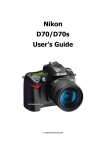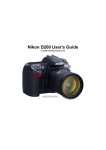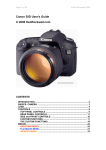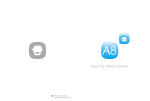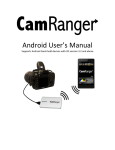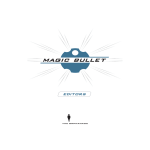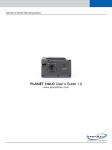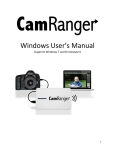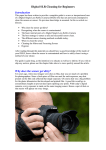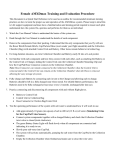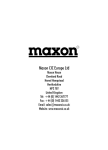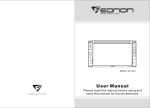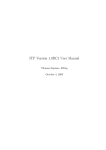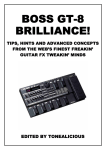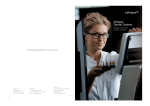Download Nikon D80 User`s Guide PDF
Transcript
Page 1 of 57
© Ken Rockwell 2007
Nikon D80 User's Guide
© 2007 KenRockwell.com
CONTENTS
INTRODUCTION.......................................................................... 2
BASICS: CAMERA SETTINGS .................................................. 3
TOP RIGHT PANEL CONTROLS .......................................... 11
REAR PANEL CONTROLS ................................................... 15
FRONT and SIDE CONTROLS ............................................. 23
FRONT RIGHT CONTROLS .................................................. 26
PLAYBACK MENU ("[ > ]" icon).............................................. 28
SHOOTING MENU (camera icon)............................................ 30
CUSTOM SETTING MENU (Pencil icon)................................. 36
SET UP MENU (wrench icon) .................................................. 49
RETOUCH MENU (brush icon)................................................ 55
Page 2 of 57
© Ken Rockwell 2007
INTRODUCTION
This will teach you to be an expert on the Nikon D80's controls
and menus. It also includes a lot of tips, tricks, and the settings I prefer to use.
To get great photos you still need to get yourself to the right place at the right
time and point the camera in the right direction, which is a lot harder than
mastering the D80. Right out of the box at default settings the D80 does a
great job so long as you preset the exposure compensation to -0.7. Making a
great photo involves locations, timing, patience and a whole lot more.
Below are the basics. Explicit details follow in later pages.
Many tricks are in the pages below. Feel free to skim to find these great tricks,
like inserting your © and contact info automatically into every file, preventing
blinking with flash photos, making the zoom preview image go away
immediately and Auto ISO.
I share this, free for the reading, because I love to help. This guide
is copyrighted and registered with the United States Library of Congress.
It is forbidden to reproduce, print or do anything else with
this without written permission, especially if you have any plans to hand it out,
email or copy it to anyone for any reason.
It's OK to make one print for your camera bag, ¶which is the only permitted
use of this PDF.
It took me two months to write this D200 User's Guide. I work for tips.
If you find it as helpful as a book you might have had to buy or a workshop
you may have had to take, feel free to help me write more.
Feel free to send me a few bucks at KenRockwell.com/donate.htm,
or by mail at:
Ken Rockwell
PO Box 8778
La Jolla CA 92038
THANKS!
Ken
Page 3 of 57
© Ken Rockwell 2007
BASICS: CAMERA SETTINGS
I leave most settings at their defaults.
I shoot with the top left mode dial in P, Program Exposure mode.
Many of these menu options are shown only after you select the FULL
MENUS option in the Setup Menu and are often deactivated in anything
except the P, S, A and M modes.
I reset everything every time I use my camera, much as a pilot uses a
checklist before flight to prevent any switches from being in the wrong
position. When I don't check first, I often have left my D80 in some screwy
mode from shooting in the dark the night before.
Nikon has an easy reset feature. I use it every time! My standard operating
setting is only a few clicks different from the defaults.
RESET
Find the two buttons with green dots next to them on the top right of the D80.
They are the +/- * and AF * buttons. Hold them both down for a few seconds.
The top LCD blinks and everything is back to normal.
I do this every time I use my D80. If I forget, I may have the resolution or
White Balance or ISO or God knows what set to something screwy and spoil
all my shots. I'll see WB problems on the LCD, but I won't notice if I left my
D80 at ISO 1,600 from the night before. That's why I always use reset.
Reset leaves the detailed menu tweaks alone. It's smart enough to reset only
the big dumb things I might have moved overnight.
Reset resets flash exposure compensations and sync modes, but doesn't
reset any screwy settings you may have made in Custom Setting 22 for
remote or manual flash. Reset resets mostly everything tactical, which is
mostly you see on the top LCD. It leaves alone strategic items like languages,
file numbering and Optimize Image settings.
Page 4 of 57
© Ken Rockwell 2007
QUALity
I use Large, JPG, BASIC.
Reset brings you to NORMAL JPG. Once I've reset I'll immediately change to
my preferred QUAL setting: BASIC. Do this by pressing the QUAL button
(bottom left rear) and spinning the rear dial one click to the right. This shows
as L and BASIC on the top LCD. L stands for Large image size (3,872 x 2,592
pixels) and BASIC JPG compression.
I'm a data cheapskate. I prefer small files. For most people not shooting
hundreds of throw-away images a day, feel free to leave it in NORMAL.
NORMAL makes files twice as large with a tiny bit less blockiness if you're
looking closely at the files printed 3 feet (1m) wide. I prefer smaller files in
exchange for almost invisible levels of blockiness.
See my D200 Quality Settings page for more explicit detail and examples of
these settings on a D200. My D80 does the same thing, but lacks the
Optimize Quality JPG Compression mode I prefer on my D200.
Exposure Compensation
I set my exposure compensation to -0.7 because my D80's metering firmware
is defective. It usually overexposes.
Set -0.7 by holding the +/- button we just used for reset and turning the rear
dial two clicks to the right.
Sadly we'll often have to adjust this depending on the subject. It's no big deal:
just look at the image on the LCD and click it towards the left (+) to lighten the
image, and to the right (-) to darken it for the next shot. This is why I prefer my
D200, which has a superior meter because it rarely needs any fiddling.
Shutter Advance Mode
I use Continuous (the bearded rectangle). I get one shot with one press of the
shutter, and if I hold the shutter button my D80 shoots three frames per
second. I do this in dim light so I can pick the sharpest image. For most shots
of moving things I fire several rounds and pick the one with the best
expressions and gestures. Of course I use a professional sorting tool on a 30"
screen to make selecting files trivial.
These are the only things I change from the reset mode. Everything else I
tweak below is unchanged by reset.
Page 5 of 57
© Ken Rockwell 2007
ISO
I use 100 and Auto ISO. Auto ISO increases the ISO automatically as it gets
dark so I don't have to. It shoots at ISO 100 in good light, and at 1/15 of a
second (or any speed you choose) it starts ramping up the ISO to a maximum
of 1,600 (or any ISO you choose) as it gets darker. Only if it gets still darker
will it let the shutter speed go below 1/15 at ISO 1,600, exactly as I'd do
manually.
I explain how to set Auto ISO and select the shutter speed at which the ISO
starts to increase and the maximum ISO to which it will increase in the
Custom Setting 07.
I set Auto ISO to 1,600 max because the noise from the D80 at ISO 1,600
looks much better than blur. I set 1/15 because my Nikon 18-200mm gives
great results down to 1/15. I adjust the lowest shutter speed setting in the
AUTO ISO menu if I change conditions or lenses. Unlike film, my D80 looks
great at high ISOs, so I use them anytime I need them. More details, including
how to set ISO to 3,200, at the ISO Button.
WHITE BALANCE
I use AUTO and a clear UV filter to protect my lens. The D80 has a much
warmer color balance than earlier cameras like the D70 so I don't need the
81A filter or the -3 trim. See examples of different settings here and details on
my White Balance page. White balance is how you set the color balance, and
color is critical. It's also personal preference. Use whatever looks right to you.
My D80's LCD is very accurate. If it looks different in print or on your
computer, your printer or computer are out of calibration.
Luckily AUTO works great most of the time. I look at my LCD, and if it's not
right, I'll set it to whatever looks good. Usually that's the Direct Sun or Cloudy
positions. These settings give much warmer results than earlier cameras. I
rarely use the warmer Shade setting on my D80 while I used Shade often on
my D1H and D70.
Page 6 of 57
© Ken Rockwell 2007
OPTIMIZE IMAGE
This is set in the Shooting Menu. I crave vivid color! I tweak my D80 to give
color as vivid as I can get. If it went to 11 I'd use that, too.
I go to MENU > Shooting Menu (green camera icon) > Optimize Image >
Custom.
Here's how I set each item under Custom:
Image Sharpening: Auto (default).
Tone Compensation (contrast): Auto (default). The D80 automatically
adjusts its contrast and dynamic range to each and every shot. It works great.
Color Mode: IIIa (three-a). This is critical: this gives brighter colors than the
default of I. No, color mode II is pronounced "two" and not to be confused with
11 (eleven). You don't want Mode II even if you could use it. Details are here.
Saturation: +, of course. This gives brighter colors in addition to the boost
from Color Mode III.
Hue: 0 (Default). Don't touch this! it will subtly mess around with your colors.
Leave it at 0.
After setting this it's critical to save it by selecting " Done" and clicking to the
right actively to select OK. If you forget to hit OK it won't remember all these
settings!
Read more at Shooting Menu.
FOCUS (AF) Mode
I use the default of AF-A. This mode automatically selects between the two
older modes, AF-C and AF-S. These are explained under AF Area Modes.
METERING
I use Matrix. You set this by holding the rectangle-with-a-dot-in-the-middle
button to the left of the +/- button near the shutter release. Leave it at its
default of Matrix, shown on the top LCD as the same weird icon as on the
button.
Seeing how poor the matrix meter has become in the D80 (it requires
constantly varying levels of compensation) I intend to try center weighted
metering. With my intimate knowledge of the Zone System, it might let me nail
the correct exposures more quickly. That would be a big step backwards;
center weighting went obsolete in the mid 1980s then the Matrix meter was
invented.
Page 7 of 57
© Ken Rockwell 2007
LENS SETTINGS
Many lenses have no switches or settings. If so, don't worry.
If the switch says "M/A - M " then use M/A. This gives autofocus, and if I grab
the focus ring it instantly lets me make manual corrections. As soon as I tap
the shutter button again I get autofocus. This M/A setting, if the lens has it,
provides both kinds of focus without ever having to move any switches. It's
the best.
If a lens has an "A - M" switch, leave it at "A." To get manual focus you may or
may not have to move the switch on the lens, and/or the switch on the
camera.
Different lenses require different settings on the camera and lens to get
manual. Some, like the old 300mm f/4 AF, required moving both the camera
and lens switches! Others, like the new Nikon 18-135mm, require no
switching and you may grab the manual focus ring at any time, even in the A
mode. Read your lens' manual, or in the USA ask Nikon 24/7/365 at (800)
NIKON-UX.
Non-G lenses will have an aperture ring on the base of the lens where it's
attached to the camera. Set this this ring to the smallest aperture (largest
number), usually 22, if not 32 or 16. This number will be orange on autofocus
lenses. There usually is a lock to keep this ring set there, since if it comes off
that setting you'll get an error message from most cameras.
These were the basics. Keep reading for explicit details.
Page 8 of 57
© Ken Rockwell 2007
TOP PANEL CONTROLS - Left
Mode Selector Knob
(On top left.) Spin it to select among P, S, A and M exposure modes. I ignore
the green AUTO and the other convenience modes (flower, lady in hat, etc.).
Many of the menu options are shown only after you select the FULL MENUS
option in the Setup Menu and are often deactivated in anything except the P,
S, A and M modes.
Page 9 of 57
© Ken Rockwell 2007
P: Program Automatic Exposure Mode
I use "P" for program auto exposure. In this mode the camera chooses the
f/stop and shutter speed for you.
If I want different apertures or shutter speeds I rotate the rear command dial,
which selects alternate combinations of f/stops and shutter speeds which give
the same exposure. Nikon calls this "Program Shift." A *P symbol appears on
the top LCD lets you know you've chosen a different combination for
exposure.
The *P doesn't appear in the finder, but you can see the apertures and shutter
speeds.
Three easy ways to return to the standard program combination are to:
1.) flip to a different mode and back to P, or
2.) turn the D80 off and back on, or
3.) spin the rear dial back to its original position.
The *P symbol goes away when you've returned to the standard
combinations.
The standard combinations are f/1.4 @ 1/8, f/2 @ 1/15, f/2.8 @ 1/30, f/4 at
1/60, f/5.6 @ 1/125, f/8 @ 1/250, f/11 @ 1/500, etc.
A shifted set might use f/2.8 @ 1/2,000, f/4 @ 1/1,000, f/8 @ 1/500 or might
use f/2.8 @ 1/4, f/4 @ 1/2, f/5.6 @ 1 sec, etc. Don't worry, just flick the rear
dial until you get the combination you prefer.
A, S and M Modes
If you want to use only one aperture or one shutter speed then use S or A
mode and the camera will automatically pick the other value. I never use
these; I shift the program instead.
If you want to set both the hard way, use M, manual, mode.
In these three modes you select the aperture with the front dial and the
shutter speed with the rear dial. You can reverse which dial does what in the
Custom Setting 15.
In A or S mode you can only set one of the two values because the camera is
setting the other one for you.
A Mode: Aperture Priority
In A mode you choose the Aperture and the D80 chooses the shutter speed.
Page 10 of 57
© Ken Rockwell 2007
S Mode: Shutter Priority
In S mode you set the Shutter and the D80 sets the aperture.
If the D80 runs out of available apertures you easily can get under or over
exposure in S mode: watch that the D80 can select a correct aperture for your
lighting.
M Mode: Manual
You set everything the hard way. I look at the LCD to check exposure. You
can use the bar graph in the finder - but why? If you wanted to do that use
another mode and let the D80 do the setting for you.
HINT: Due to a continuing firmware defect, AUTO ISO doesn't deactivate in
Manual mode. I always turn off AUTO ISO when I enter Manual Mode,
otherwise Auto ISO changes ISO on you and ruins your intended exposure.
Page 11 of 57
© Ken Rockwell 2007
TOP RIGHT PANEL CONTROLS
OFF, ON, Light and Shutter Release Button
Leave it ON unless you're putting it away. It draws no more power in ON than
OFF. OFF is a lock to prevent accidental operation in your case.
Twist it clockwise to illuminate the top LCD.
Page 12 of 57
© Ken Rockwell 2007
FORMAT and Weird Rectangle Button
This is the metering switch.
I always use Matrix, shown by an icon on the top LCD which looks like the
same weird rectangle on the button.
Hold the weird rectangle button and spin the rear dial to set the metering
modes to Matrix (weird rectangle), center weight (a dot with a ring around it)
or spot (a small dot), as seen on the top LCD. There is no indication in the
finder.
Hold this and the other FORMAT button on the top left rear to format the
memory card. I do this every time I shoot. Hold down both buttons and the top
LCD flashes "For." Hold them both down again and the card is formatted. This
erases everything, and ensures you won't be getting any errors.
Professionals reformat a card each and every time a card is put in in the
camera. This is because files and folder structures are sometimes messed up
or changed when the card is read in-camera or with a reader or used in any
other camera. Professionals prefer to be safe than sorry. We don't use cards
to archive previous photos. One time I kept saving my winner shots on a card
by simply erasing the rest each time. After a few months I started to get
errors. These went away as soon as I reformatted the card. Reformatting
completely renovates the card. Erasing does not, and leaves potential errors
lurking.
Page 13 of 57
© Ken Rockwell 2007
+/- and Green Dot Button
This exposure compensation button is very important. You'll probably wear
the paint off this one. This button makes the photos lighter or darker. + is
lighter, and - is darker.
A flaw in the D80's firmware makes most photos too light, so I leave mine set
to -0.7. If your photo is too light, hold the +/- button and spin the rear dial to a
more negative number, like -1.3. If your photos are too dark, hold it and spin
the dial to a more positive number, like -0.3 or 0.0. It's perfectly OK to go to
any number you need, like -2.3 or +1.0.
This only affects photos as you take them. Use whatever setting looks best.
This error isn't a simple calibration issue. The D80 does different weird things
with different subjects. The D80's meter firmware is designed erroneously to
expose for the darkest part of the image, so it's almost impossible to get the
right exposure of someone wearing black, especially as they move around the
image. You may need -2.0 or -3.0 compensation, while other shots of light
objects may be fine with 0.0.
It is this need for constant variation and supervision which makes this meter
so bad and why I prefer my D200. The D40 is the same as the D80.
Flash exposure is Nikon's usual perfection.
HINT: You can see the + or minus value displayed in the finder as well as the
top LCD, so you can adjust this without taking your eye from the finder. The
finder display only reads the value when the button is pressed, otherwise
those digits read exposures remaining.
Hold this and the other green dot button below at the same time for a few
seconds to reset most settings to their defaults as explained on the first page.
I do this every time I shoot to cancel whatever whacky settings I may have
been using before.
Bearded Rectangle, Backwards Clock and Remote Clicker Button
This controls how the shutter fires. Hold it and turn the rear dial, or press it to
cycle among the various modes. The modes are shown on the top LCD.
[S]: Normal mode is shown as an [S] in a rectangle on the top LCD, as shown
above. The D80 takes one picture each time you press the shutter, regardless
of how long you hold the shutter.
Bearded Rectangle: The D80 takes one picture if you press the shutter and
release it. The D80 takes photos at about three frames per second if you hold
down the shutter. I use this mode because I have my choice of one or many
shots depending on how long I hold the shutter. In dim light I hold it for many
exposures so I can pick the best one later.
Page 14 of 57
© Ken Rockwell 2007
Backwards Clock: Self Timer.
Rectangle with Hole (Remote Control): This lets my D80 fire from my
excellent ML-L3 remote control. It's the best $20 you'll spend and it works with
the D70 and D40, too. The D80 has to stay on in this position, which is why it
turns off automatically after a period of a minute or so as set in Custom
Setting 30. I use this mode on my tripod and for self portraits.
You can get the backwards clock and remote icons to show at the same time,
in which case the D80 fires after an interval after you press the remote.
AF and Green Dot Button
This sets the autofocus mode. You can tap it to cycle through the settings, or
hold it and spin the rear dial.
AF-A, the default I use, magically selects between the next two modes.
AF-S stands for AF-Single. The D80 focuses once, then locks AF for you to
recompose and shoot.
AF-C stands for AF-Continuous. The D80 keeps focusing as the subject
moves. Use this for sports and vehicles in motion, like cars, birds and aircraft.
I covered green dot reset on the first page. It resets most of the D80 settings.
I reset this every time I shoot.
Page 15 of 57
© Ken Rockwell 2007
REAR PANEL CONTROLS
From top left to bottom right:
Trash Can and FORMAT Button
This is the D80's dual-purpose flush lever. Press it while a photo is displayed
to erase that photo. You'll get an "are you sure?" screen, and press it again to
dump that shot. Meatheads like me get used to double pressing it every time
out of habit, which means I accidentally erase some shots. Serves me right.
Pressing and holding this FORMAT button along with the other FORMAT
button on top formats the card (erases and resets everything on the memory
card) as explained above.
Page 16 of 57
© Ken Rockwell 2007
[>] (Play) Button
This plays an image, or stops playing an image.
You don't need this often, since the LCD turns off the instant you tap the
shutter button, and if you set Image Review ON in Custom Setting 06 it plays
automatically after each shot.
With Custom Setting 06 set to ON, you can do anything and everything to the
image immediately after shooting without having to press Play. Want to zoom,
scroll, or see other images? Just move the appropriate controls.
I thank my lucky stars with my Nikon, because on my idiotic Canon 5D I have
to wait and press the Play button just to zoom in on a shot I just made! No
need for this with Nikon, so long as you have Image Review set to ON.
The only reason you may want Image Review OFF (its default) is if you prefer
to make many immediate changes to your next shots.
If Image Review is ON, the image pops up after your shot, and the D80
interprets your front and rear dial commands as next/back and info page
scrolling. My D80 won't be reading the command dial inputs to change
apertures or shutter speeds until I wait a moment and tap the shutter to put
the D80 back into Shooting mode. If you want to change your settings
immediately, turn off Image Review. The Canon Rebel XTi is smarter than the
5D, since the XTi has a sensor to determine if you have your eye at the
viewfinder and switches automatically.
MENU Button
This gets you into the menus, as explained at the many menu pages below.
Page 17 of 57
© Ken Rockwell 2007
WB / ? / Key Button: WHITE BALANCE
1.) If playing (note the color code: yellow: play, silver: shooting), it locks the
image from deletion. I never do this, since it makes it a pain to erase later
from my computer. Of course Formatting the card erases everything!
One trick for which I use the lock is if I forgot to format the card when I started
shooting. I lock the few new shots, then use the DELETE ALL command in
the Play Menu to dump all the old stuff I didn't lock. I then have to unlock each
shot and proceed normally.
2.) If setting the menus, pressing this ? button often gets help and
explanations of what's going on with that menu item.
3.) If not playing back, then you're in shooting mode. Hold this button and turn
the front and rear dials to set the White Balance. You can see the setting on
the top LCD.
The rear dial makes selections among the major settings. The front dial finetunes the setting from -3 (warmer or redder) to +3, cooler or bluer.
I leave my WB at AUTO. See also How to Set White Balance and White
Balance Examples.
Here is a run down of the individual WB settings from left to right, as shown
on the bottom of the top LCD:
Auto (A): I use this all the time. It makes its best guess for WB. It's usually
very good. Indoor tungsten can be too orange unless you have some bright
tungsten light also in the image. If you do, it removes the orange and
compensates completely. If not, the D80 only partly compensates and you get
a nice warm image instead.
Tungsten (hanging light bulb icon that's easy to confuse with the sun icon):
This makes the picture very blue. Use this only for deliberate Arctic freezing
effects, or under conventional tungsten light bulbs.
Fluorescent (glowing tube icon): Used to make crappy fluorescent light look
less crappy. These settings rarely work; use the preset setting for better
results.
Direct Sunlight (sun icon): Use this outdoors in direct sunlight. Use other
settings for shadows or indirect sunlight.
Flash (lightning bolt icon): I never use this. It's almost the same as direct sun.
I'm told it's really for studio strobes, since the Auto mode compensates
magically for flash if you use it on-camera. The reason to use this is if you use
a different trim value for your strobes than you do for sunlight.
Page 18 of 57
© Ken Rockwell 2007
Cloudy (cloud icon): Warmer (oranger) than the sunlight position. I use this in
shade, too.
Shade (house casting a shadow icon): very warm (orange). Use this for
sunset shots and deep shade.
K (Continuously Variable): This setting lets you choose any amount of blue or
orange. Once you select "K" you choose the value, from 2,500 to 10,000, with
the front knob while holding WB. The calibrations are abstract in what we
scientists call (degrees) Kelvin. More degrees look warmer (oranger) and
fewer degrees looks cooler (bluer). There are no rules in real-world
photography: use whatever setting looks best to you.
2,500 K is very, very blue. I'll use something around 2,650 K in dim home
lighting to get neutral results. 3,200 K is the same as tungsten above. 5,400 K
is the same as direct sun above. I'll use something around 4,000 K indoors
with a mixture of sun and tungsten light. 10,000 K is very, very orange. The
shade setting is similar to 7,500 K, and 10,000 K is warmer.
Preset (PRE): You use this setting with a white or gray card to get perfect
color matching. Hold "WB" and spin the front knob after choosing PRE with
the rear knob.
To set it to a white or gray card (or anything neutral):
1.) Ensure your card or other neutral object is in the light representative of the
light on the subject.
2.) Hold WB and spin the rear dial to get to the PRE setting.
3.) Release the WB button.
4.) Press and hold the WB button again for a few seconds.
5.) PRE starts to blink.
6.) Release the WB button.
7.) Point your camera at the card or neutral colored thing and Press the
shutter.
8.) If the display flashes "good" you're set.
9.) If the display flashes "ng" then repeat from step 4.)
Page 19 of 57
© Ken Rockwell 2007
ISO / Minifying Glass / Checkerboard Button
If playing, it reduces the images to fit 2x2 or 3x3 on the screen. If the image
was zoomed, it zooms out.
If shooting, hold this and turn the rear dial to change the ISO, or sensitivity to
light. I usually leave my ISO at 100 and let the D80's Auto ISO adjust as
needed.
Auto ISO makes all the ISO adjustments for you. I always use Auto ISO since
it's as smart as I am.
Higher ISOs can give sharper images in dimmer light because they let the
D80 shoot at faster shutter speeds or smaller apertures, but they also can add
more grain (noise) to your photos.
ISO 100 gives the cleanest images, but the most potential for blur in dim light.
I use ISO 100 outdoors.
ISO 400 and ISO 800 are perfect for sports outdoors.
ISO 1,600 gives the noisiest images, with the least potential for blur. ISO
1,600 still looks pretty good if you need it, but I only use it indoors.
ISO 3,200 is for use as a last resort. It is grainy, and lets you shoot in the
dimmest light without flash.
Auto ISO selects magically among all these (except for ISO 3,200) so you and
I don't have to worry about it.
Firmware Flaw: ISO goes from 100 to 3,200. Above ISO 1,600 Nikon uses
bizarre terminology to scare amateurs away from setting these, because
these same amateurs would clog up Nikon's (800) NIKON-UX support lines
complaining about grainy photos.
Nikon calls ISO 2,000 "Ho.3," ISO 2,500 "Ho.7" and ISO 3,200 "H1.0."
HINT: If you've selected Auto ISO then you cannot set a manual ISO higher
than you allow in Auto ISO. To get to ISO 3,200 (cryptically called H1.0 by
Nikon) you must turn off Auto ISO.
Page 20 of 57
© Ken Rockwell 2007
QUAL / Magnifying Glass Button
If playing, zooms in. Use the up/down/left/right button to scroll around.
TRICK: When zoomed in, flicking the rear dial will go forward/back among
other images, all at the same zoom and location. (The Left/Right/Up/Down
key still moves around inside the zoomed images.) This makes it easy to see
which shots in a sequence are sharp or not. The bad news is that when you
delete one that the monitor returns to the default full-image view.
If not playing, press this and spin the dials to set the kind of file, the size of the
file and the size of the image. You read the setting from the top LCD.
The rear dial controls the kind of file (raw, JPG or both), and the size of the
JPG file (FINE, NORMAL or BASIC).
I always use JPG, never raw. (see JPG vs. Raw.)
I usually use BASIC JPG and sometimes NORMAL JPG.
BASIC JPG looks almost the same as NORMAL, unless you're making six
foot wide prints. It also makes a file half the size of Normal, which speeds up
everything and saves space on my hard drives and backup CDs.
I never use FINE; it looks the same as NORMAL and wastes space. Feel free
to use any settings you like; that's why they're here.
The front dial selects L, M or S image (pixel) size for the JPG images. I
usually use L or M.
You can see examples from my similar D200 at D200 Quality Setting
Examples.
AE-L AF-L Button
This locks the focus or exposure. You select what it locks in Custom Setting
18. I set mine to lock exposure for as long as I hold the button.
Rear Dial
Click this left and right to control most of the D80's functions. You can reverse
which dial does what in Custom Setting 15.
Page 21 of 57
© Ken Rockwell 2007
Up-Down-Left-Right Key
This is the four-way thumb switch.
While playing, this moves among your images and the data for them. I find it
more convenient to spin the front and rear dials to do the same thing; try it.
When playing a zoomed image, it scrolls around the image.
Trick: After zooming, push the center to make the little zoom preview go away
immediately! Otherwise you have to wait a second or two.
While shooting, it selects the AF areas.
In the menus, it moves around your selections.
Dot - L Slide Switch
Locks the Up/Down/Left/Right switch, but only in the shooting mode.
While shooting, L (lock) makes the D80 ignore the Left/Right/Up/Down key.
This keeps your selected AF area unchanged.
It doesn't have any effect in the other modes. Smart!
Almost Invisible (when off) Green Light
This light should be red, because it means the D80 is talking to the SD
memory card and you must not remove it. If you're dumb enough to yank out
the card with the light on, you not only will lose some photos, you may destroy
your SD card.
This normally blinks when the D80 is turned on or off or wakes up to shoot. It
blinks for a moment after each shot to record it to the card. it blinks as you
select different playback images as it reads them from the card.
It can stay lit for a minute or more while data gets written, if you insist on
shooting a lot of fast sequences in raw.
You may ignore it while shooting. You don't have to wait for it, except to pull
out your SD card. The D80 has a fat buffer to let you shot as fast as you want
without having to wait for this light.
Page 22 of 57
© Ken Rockwell 2007
OK Button
In playback, calls up the Retouch Menu. If zoomed in (or zoomed out to the
2x2 or 3x3 modes), it returns you to a normal sized image.
In menus, sets menu items.
The D40 is much better, since it puts the OK key in the middle of the
Up/Down/Left/Right key.
Page 23 of 57
© Ken Rockwell 2007
FRONT and SIDE CONTROLS
From the top down:
+/- Lightning Bolt Button
1.) Press once to pop up the built-in flash.
2.) Hold and spin the front dial to alter the brightness of the flash. 0.0 is
normal and I leave it there almost all the time. Only in rare instances do I ever
need to adjust it towards the minus side to make it darker, or the plus side to
make it lighter.
3.) Hold and spin the rear dial to select flash sync mode. The Sync Mode is
displayed in the box with the lightening bolt on the left of the top LCD. Here
are the modes and what they do:
Normal (blank, which is the default): In Program and A exposure modes, the
shutter won't stay open longer than about 1/60 second. You can change this
minimum speed in custom function 24, which defaults at 1/60 second. I forget
the exact default because I have mine set to 1/15.
Page 24 of 57
© Ken Rockwell 2007
In this mode you won't get blur indoors, but you may not get more than a very
black background either. Choose a longer speed, like 1/8, in custom function
24 to lighten the backgrounds indoors, but watch for motion.
I usually use Normal mode and a custom function 24 setting of 1/8 or 1/15,
since in SLOW mode I can get scary long exposures in the dark.
This little trick of being able to select the exact slowest shutter speed in these
modes is a significant reason why I prefer my Nikons over my Canon SLRs.
Red-Eye (eyeball icon on top LCD): I never use this. It shines an obnoxious
light in your subject's eyes for a couple of seconds and then releases the
shutter. If I set this mode by accident it bugs the heck out of me, because the
camera doesn't go off until several seconds after I've pressed the shutter, but
I have no idea why because I've set no self timer! It doesn't do much to
reduce redeye anyway. Skip this mode.
SLOW (called SLOW on the top LCD): This mode is very useful. It lets the
shutter stay open as long as it needs to so dim ambient light can expose
properly with flash. Of course if it's dark these exposure times can get long.
You can get blur from subject motion and camera shake. In daylight SLOW is
the same as NORMAL, since exposure times are short. SLOW unlocks the
camera in P and A exposure modes to make exposures as long as it wants to
in dim light.
Have a look at most issues of National Geographic and you'll see many
indoor shots made in this mode. The background exposes correctly, people
may be blurred, and a burst of flash freezes them along with the blurry ghost
images.
Normal and SLOW do the same thing in S and M exposure modes, since you
or the camera may select any shutter speed in these modes regardless of
flash sync.
I usually prefer to choose an exact slowest shutter speed in the Normal mode
as explained above. In SLOW mode and dark conditions the shutter speeds
can become too long for comfort.
Red-Eye SLOW (eye and SLOW icon): This is the SLOW mode and redeye. I
don't use it for the same reason I don't use Redeye.
REAR (called REAR on the top LCD): Normally the flash goes off the instant
the shutter opens. With long exposures and blurred ghost images you
ordinarily get the ghost streaming out in front of the subject. Think about it: if a
car is driving, the flash goers off and freezes it, then the car moves forward.
You'll have a ghost image ahead of the car, which usually looks stupid. Select
REAR mode to have the flash go off as the shutter closes. Now you'll have
motion blurring behind the frozen flash image.
Page 25 of 57
© Ken Rockwell 2007
Another reason to select REAR is because the flash goes off at the end of the
exposure. People presume photos are made the instant a flash fires, then
leave. This wreaks havoc with long exposures. If you use REAR mode with
long exposures they'll stay put and not move until the end. Of course you'll
also want to select flash lock to eliminate the preflash.
REAR doesn't do anything with short exposures.
Trick FV Lock Mode: You can set this in the Custom Menus. I cover this
below. It prevents people from blinking with flash!
BKT Button
Bracketing. I never use this. Bracketing was a popular crutch used by new
photographers who couldn't get their exposures correct on film. Ansel Adams
(and I) thought bracketing was very bad, because it was more work than
learning how to expose correctly and because it usually guarantees that your
best exposure is at the wrong instant, making you lose 2/3 of your good shots.
Today the D80 has a great LCD and color histogram for getting the correct
exposure. Use them, not bracketing.
Big Button Above AF - M Switch
This unlocks the lens. Push this straight in and rotate the lens to remove it. It's
a bayonet mount.
AF - M Switch
Autofocus or Manual focus. If your lens has the same switch, you usually can
leave this at AF and use the switch on the lens to select manual. Some lenses
are different; see your lens manual or ask Nikon in the USA at (800) NIKONUX.
Page 26 of 57
© Ken Rockwell 2007
FRONT RIGHT CONTROLS
Front Dial
This is used to fine-tune most settings. You can reverse which dial does what
in Custom Setting 15.
Top Unmarked Button to Left of Lens Mount:
FUNC (Assignable Function) button
This button can be programmed to many clever tricks. I wish my Nikons had
more of these!
You set what it does in Custom Function 16. I leave mine on flash exposure
lock (Bolt FV Lock), which lets me make flash photos without people blinking.
Tap it to fire the flash and set the exposure, and subsequent photos won't
need to fire a preflash, which ensures people blink.
Read Custom Function 16 to learn all the clever things it can do.
Page 27 of 57
© Ken Rockwell 2007
Bottom Button Below Lens Mount: Depth-of-Field Preview Button
Tap this to stop the diaphragm down to the taking aperture. The viewfinder
probably gets darker, but look carefully and you can see what's in focus or
not.
This analog feature is a remnant from film days. Today most people look at
the LCD playback.
Safety Defect: Nikon has a flaw in the firmware which fires a huge, blinding
burst of flash when you press this button. You must disable this in Custom
Function 26 to save your eyesight. The blinding flash burst is intended as a
way to let you preview the effects of flash or multiple flashes. The defect is
that it is left ON by default.
Page 28 of 57
© Ken Rockwell 2007
PLAYBACK MENU ("[ > ]" icon)
How to Get Here
Press MENU, click to the left and then up to select the top "[ > ] " (play) icon.
You'll then see PLAYBACK MENU at the top of the color LCD.
What it Does
It sets various playback options, including what data you see on playback.
What I Change
I leave it alone.
Delete
This is helpful if you want to delete all images while saving those for which
you pressed the Key / WB / ? button to lock. I don't use this. I do all my editing
and selection in my computer and I do my in-camera deletions one-by-one
with the trash can key.
Playback Folder
The camera can record to and play back from different folders.
ALL shows you everything on the card. I leave my D80 set to ALL. It tends to
reset itself to D80, meaning it won't play images made on a different camera if
they are on your card.
CURRENT ignores photos in folders other than the one to which you're
recording.
Rotate Tall
This is Japanese for rotating the vertical shots on playback, presuming you've
set Auto Rotate to ON in the Setup Menu. It doesn't affect your images or
files; it only changes how they are displayed on the D80.
Slide Show
This lets you amaze your friends with an exciting slide show on the tiny
screen. I don't bother with this. I guess it's popular in Japan. Whoo hoo! Let's
all watch a show on a 2.5" screen! You could plug the D80 into a TV or video
projector, but video resolution is so bad everything will look awful.
Page 29 of 57
© Ken Rockwell 2007
Hide Image
This is used to hide embarrassing photos of your friends from playing back
before you get to download them. The images are on the D80, however when
marked this way they will be skipped on playback as if you deleted them.
Move the cursor left and right to select images, press the center to mark as
Hide or Unhide, and press ENTER to save. Now the camera won't play these
images, even though it still tallies them in it's counter on the top right that
reads "34/284." You can detect a hidden image because this counter will skip.
Print Set
I never use this. I guess it's popular in Japan. This lets you mark images for
printing if you sorted and then printed directly from your D80, and had a lab
which could read this data.
Page 30 of 57
© Ken Rockwell 2007
SHOOTING MENU (camera icon)
Many of these menu options are shown only after you select the FULL
MENUS option in the Setup Menu and are often deactivated in anything
except the P, S, A and M modes.
This menu really should be called the Film menu and shown with an icon of a
roll of film. More camera settings, like autofocus, flash and timers, are set in
the Custom Settings Menu, shown by a pencil. This is Nikon's mistake; don't
penalize yourself if the menu names and icons make little sense at face value.
How to Get There
Press MENU, click left and then up and down to select the camera (shooting)
menu. You'll see "SHOOTING MENU" on the top of the LCD monitor.
What it Sets
It sets parameters related to what film used to do. The Shooting Menu sets
ISO, grain, contrast, color and a zillion other critical things that set the look of
your images.
The shooting menu would make more sense if it were called the Film menu,
since many other menus also affect shooting.
What I Change
I change a lot here. This is where I get the wild colors I love from my D80.
Optimize Image
This is where you set the look of your image, like the saturation I love.
These choices are art. There is no right or wrong if you know what you're
doing and know what you want.
I'll tell you what I use. Ignore me and be yourself if you prefer a different look.
Page 31 of 57
© Ken Rockwell 2007
Preset Choices
There are five fixed preset modes. They cannot be altered. They are:
N Normal
SO Softer
VI Vivid
VI* More Vivid
PO Portrait
BW Black-and-White
Black-and-White is a sixth preset mode which does have some adjustments
under Custom. The Filter Effects menu under Custom lets the D80 create
images which look as if they were shot through a colored filer on black-andwhite film. I leave mine set to the RED filter, which increases the contrast of
clouds against the sky.
You might think I would use Vivid or More Vivid, except that they crank up
some of the contrast and sharpness settings and leave them there. I want
vivid colors, but leave the contrast and sharpness on Auto. This way as
subjects get contrastier I don't have to stop and turn the contrast back down.
In VI* you can easily blow out a slightly high-contrast scene.
Therefore I use the Custom (pencil icon) setting:
Custom (pencil icon)
This is where Nikon hides the critical adjustments other camera makers make
more obvious.
Canon lets you define many of these and recall them easily. Nikon only gives
you one setting. Canon also gives you a wider and more precise range of
adjustments, and therefore it's easier to make bad mistakes with Canon. The
extreme settings here aren't very extreme. Play to your heart's content and
see what you prefer.
Done
"Done" is the most important Custom Optimize Image menu item. If you forget
to select it and then click to the right to select OK it forgets everything! Always
remember to select DONE and OK after you change any of the settings
below, otherwise they will be ignored.
Page 32 of 57
© Ken Rockwell 2007
Image Sharpening
I leave mine on AUTO. I've never messed with the manual settings.
Sharpening is an artificial effect not to be confused with sharpness. When I
first got a digital camera I thought: "cool, I'm cranking this to 11," and realized
my error. Don't turn it up for no reason, since the image can start to look
artificial. Play with it if you want. I've played with it out of curiosity, and always
leave it on AUTO.
Tone Compensation (Contrast)
Nikon meant to say Contrast. I always leave mine set to AUTO. In AUTO the
D80 automatically applies the Zone System and adjusts contrast to match
your subject, for each and every shot!
If Nikon's marketing department was paying attention, they would promote
this as Automatic Dynamic Range Optimization, since that's what it does and
Canon has nothing like this.
The D80 automatically lowers contrast and increases dynamic range for very
contrasty subjects, and cranks up contrast for dull subjects.
Saturation also varies with this setting. If you crank it to + it looks vivid and
bold for flatter subjects, but when you have a contrasty subject it's too much
and blows out. Leave it in AUTO and you won't have to piddle with it.
Avoid Custom tone compensation. Most people call this a custom curve. I've
never used it. To use it you have to buy Nikon Capture and create a curve.
You then use Nikon capture to load it into the D80. Once you've done that you
select it here. If you haven't loaded your own custom curve and select this you
get the default Normal curve. Custom curves are way beyond anything with
which I want to bother. The curves in the camera are the best ones anyway.
Real photographers pay more attention to their subject's lighting.
Color Mode
Color Mode has three settings:
1. Color Mode Ia (one-a, sRGB) is default. It's normal and boring.
2. Color Mode II (two, Adobe RGB) gives dull colors. Don't touch this
unless you really know what you're doing and print your own work. See
Adobe RGB vs. sRGB.
3. Color Mode IIIa (three-a, also sRGB) gives bolder colors. I use it all the
time.
I have no idea how Nikon cooked up these numeric designations.
Page 33 of 57
© Ken Rockwell 2007
Saturation
This sets the vividness (strength) of colors.
A Auto: I don't use this. I suspect it cranks up the color for dull scenes and
puts it back to normal for scenes that are already colorful. I prefer always to
have my saturation cranked up.
0 Normal: For normal people shots you're probably better off with 0. This is
the default.
- Moderate: tones down the colors, which I've never liked. "Moderate"
sounds like British understatement. In America we call this "dull and boring."
Personally I want colors so bright you have to put on sunglasses, or I go
directly to B/W. Your interests and taste will differ.
+ Enhanced: I prefer violent color, so I crank it up to +. I'd use ++ or +++ if
my D80 had it, but that's me.
Hue Adjustment
Don't touch this! This rotates all your colors to different spots around the color
wheel. If you use this to fix one color it screws up all the other colors. God
only knows why this adjustment is here.
Image Quality
This duplicates half of the QUAL button. It chooses JPG, raw or both and the
JPG compression level.
See my discussion of the QUAL button for details, and see examples of these
settings at my D200 Quality Settings page.
Image Size
This duplicates the other half of the QUAL button. It chooses the JPG image
size in pixels. It does not directly choose the size of the file in bytes.
See my discussion of the QUAL button for details, and see examples of these
settings on my similar D200 at D200 Quality Settings.
White Balance
This duplicates the WB button as explained on the D80 Controls page.
Page 34 of 57
© Ken Rockwell 2007
ISO Sensitivity
This duplicates the ISO button as explained on the D80 Controls page.
Firmware Defect: the AUTO ISO options are hidden in the Custom Settings
Menu!
Long Exp. NR
This is short for Long Exposure Dark-Frame Subtraction Noise Reduction
OFF: Default. Leave it here.
ON: Don't use this. If you do, the D80 will double the amount of time you have
to wait around for time exposures of 10 seconds or longer. The D80 is so
good you don't need this. Nikon only includes this because old-timers would
get peeved if it was missing.
I have details with examples from my very similar D200 at D200 Dark
Exposures.
Minor Firmware Defect: the help menu says exposures need to be 8s or
longer for this NR to take effect. It's wrong - they have to be 10s or longer, or
longer than 8s.
High ISO NR
This is short for High ISO Noise Reduction
This lets you control the strength of the noise reduction (smoothing) applied at
high ISOs.
I find the default NORMal position optimum.
You can set it higher, but it removes subject texture.
You can set it lower and get more noise, along with more detail and
sharpness.
I have details with examples from my similar D200 at D200 High ISO Noise
Reduction.
Page 35 of 57
© Ken Rockwell 2007
Multiple Exposure
This is unique. It lets you do what we did back on film.
This works and it's easy to use.
Unlike film, it's smart enough to compensate the exposures so they add
together without overexposure.
To use it:
1.) Choose the number of shots to combine (2 or 3). 2.) Hit OK.
3.) Go up to DONE.
4.) Hit OK. It only works if you remember to scroll up and hit OK.
You'll see a tiny icon on the top LCD that looks like two rectangles mating.
Make your shots. You'll see each on the color LCD as you make it. The
mating rectangles on the top LCD are now blinking. You'll also see the mating
rectangle icon on the color LCD.
You'll keep seeing the flashing mating rectangles icon on the top LCD until
you complete all the exposures for which you asked in step 1.).
The D80 won't tell you how many you've made until you're done. You can
cancel it in the same menu if you want. Choose RESET.
When you've made the last shot the D80 shows it as it did for the other shots
for a moment, then goes off and adds them all together. After the CF light
blinks a few times you'll see the composite image on the color LCD. The
intermediate single images are not saved.
It works with JPGs and NEFs.
Don't turn off the automatic exposure compensation, called Auto Gain. If you
do you'll get at least a stop of overexposure.
Page 36 of 57
© Ken Rockwell 2007
CUSTOM SETTING MENU (Pencil icon)
Many of these menu options are shown only after you select the FULL
MENUS option in the Setup Menu and are often deactivated in anything
except the P, S, A and M modes.
This menu really should be called the camera menu and shown with an icon
of a camera, except that Nikon used the Camera icon for the shooting menu,
which really should be called the Film menu. Camera settings, like focus, flash
and timers, are set here in the Custom Settings Menu, shown by a pencil.
This is Nikon's mistake; don't penalize yourself if it makes little sense at face
value.
How to Get Here
Press MENU, go to the left and select up and down to the pencil icon. You'll
see CUSTOM SETTING MENU on the top of the color LCD.
What it Does
This menu sets many things related to the camera and taking pictures, like
autofocus, exposure, timers, flash and more.
What I Change
I change a lot here, read on.
[R] Reset
This resets everything in this menu to its defaults. I don't use this.
01 Beep
Turn this OFF!!!
This is the idiotic and annoying focus confirmation beep. Turn it off!
The beep annoys others and is very rude. Focus confirmation is indicated by
a dot in the lower left of the finder.
Page 37 of 57
© Ken Rockwell 2007
02 AF-Area Mode
This selects how the D80 uses its numerous AF sensors.
You'll want to change this for action, still subjects or handing your camera to a
non-photographer. I wish the D80 had a dedicated switch as the D200 does.
On the D80 we need to go into this menu every time our subject changes.
[ o ] Single Area is used for still subjects. I use this most of the time. The D80
uses whichever area you select with the rear Up/Down/Left/Right selector.
[ x ] Dynamic Area lets the D80 automatically select which sensor to use as a
subject moves around the frame. It really works! I use this for sports, running
animals and birds in flight.
The D80 first uses whichever area you select with the rear
Up/Down/Left/Right selector, and proceeds to select other areas automatically
if the subject moves. You won't see which area is selected in the finder, but
you can see it on playback if you use the right software.
[xxx] Auto-Area AF selects AF areas by magic, usually the closest one. Use
this when you hand your camera to a non-photographer, or if things are
moving too fast for you to do your own AF selection. This feature works great.
I'm always surprised at the great results I get in this mode.
TRICK: You can program the FUNC button to change this setting, which
would be great except I prefer to use my FUNC button for Flash Exposure
Lock.
03 Center AF Area
This selects your choice of a small or large central AF area.
I've always left mine on the default of Normal.
You can program the FUNC button to change this.
04 AF Assist
I leave this at ON.
Turning this OFF disables the bright white light that shines in the dark to help
you focus. I turn this off if I'm shooting where I don't want to disturb people, or
be identified as photographing.
Page 38 of 57
© Ken Rockwell 2007
05 No Memory Card?
I leave mine at LOCK. If I have no memory card it won't let me take pictures.
Don't set it to OK. If you do, you could have no memory card and be shooting
all day, thinking you're making pictures when you really aren't. Shoot one
wedding without a card and this set to OK and you'll see how stupid you'll feel.
Only set this to OK if you want to demonstrate the D80 in a camera store with
no card.
06 Image Review
ON plays the picture after you take it. OFF leaves the screen dark.
When the image pops on the screen, even if the D80 is still at your eye,
spinning the command dials will change the playback, not the shooting
settings like apertures. While shooting you might want not to use this, or
remember that you must wait a moment and tap the shutter release to reset
the D80 to interpret the command dials for changing shooting settings instead
of playback screens.
Page 39 of 57
© Ken Rockwell 2007
07 ISO Auto
This is one of the strongest reasons I prefer my Nikons to my Canons, which
lack this critical feature.
ISO Auto Increases sensitivity (ISO) in dim light automatically to prevent blur
from slow shutter speeds.
I use this all of the time, unless I'm using manual exposure mode. Auto ISO is
a crucial component of Modern Exposure Technique.
Today I adjust the Auto ISO's minimum shutter speed as I change lenses and
conditions. I no longer adjust ISO directly, as we did in the old days before
2004. This is a time-saving step towards the future, just as program exposure
was a step ahead of aperture priority in the 1970s.
You can choose the highest ISO to which the Auto ISO will go (Max
sensitivity). I let my D80 go all the way to to ISO 1,600, since it looks fine at
ISO 1,600 and any small amount of grain is better than a blurry photo. If you
prefer blur to grain, feel free to limit the D80 to ISO 800 or 400. Try ISO 1,600:
the D80 is better at high ISOs than film ever was, and far better than any
compact digital camera at these speeds.
You also may set the minimum shutter speed (Min Shutter Speed) below
which the D80 starts raising the ISO. Select the slowest shutter speed at
which you'll get sharp images under your present shooting conditions.
I wish this function was smart enough to recognize which lens I'm using and
adjust accordingly, but it's not.
HINT: If you've selected Auto ISO then you cannot set a manual ISO higher
than the maximum ISO set as part of Auto ISO. To get to ISO 3,200
(cryptically called H1.0 by Nikon) you must turn off Auto ISO.
HINT: You set the lowest ISO used in Auto ISO with the ISO button, of
course.
Firmware Defect: Nikon's firmware leaves Auto ISO active even in manual
exposure mode. This makes the D80 change the ISO automatically and
defeat the purpose of manual exposure. Remember to deactivate Auto ISO
when using Manual exposure mode.
08 Grid Display
This activates hairlines in the finder. I leave them ON to help me keep
everything straight and level.
You can program the FUNC button to set this more directly.
Page 40 of 57
© Ken Rockwell 2007
09 Viewfinder Warning
This superimposes warnings directly on top of the image in the finder if you do
anything bone-headed like have no memory card, have the D80 set to B/W or
if the battery is low.
I leave these ON. I want to know these things!
10 EV Step
This lets you adjust settings in your choice of third stops or half stops.
I leave it in the default of third stops. I prefer full stops, however that option
isn't in the D80. It is in the D200.
11 Exposure Comp
This is more correctly is called "Easy Exposure Compensation" on other
Nikons. Setting this ON lets the rear dial alter the exposure compensation at
any time, without pressing the +/- button near the shutter.
I leave this off, its default. I don't mind pressing the +/- button to adjust this,
and don't want to alter this critical setting accidentally.
12 Center-Weighted
This selects the diameter of the center weighted metering area.
I leave this at its default of 8mm. I never use center weighted metering, which
is a throwback to the 1970s.
13 Auto BKT Set
This selects what changes if you use bracketing. I never change this, because
I never use bracketing, and you shouldn't use bracketing either. Look at your
LCD and histogram and set the correct exposure in the first place.
Bracketing is for wimps.
13 Auto BKT Set
This selects what changes if you use bracketing. I never change this, because
I never use bracketing, and you shouldn't use bracketing either. Look at your
LCD and histogram and set the correct exposure in the first place.
Bracketing usually ensures that the best shot among many is made at the
wrong exposure.
Page 41 of 57
© Ken Rockwell 2007
14 Auto BKT order
This selects the order in which the bracketed exposures are made.
15 Command Dials
This lets you reverse the functions of the front and rear command dials.
I leave this at default.
16 FUNC Button
This selects what the FUNC button does. The FUNC button is the one on the
front of the camera, between the lens mount and the shutter button.
The FUNC button is so slick that I wish the D80 had more than one. Tricks
like each of these are why I prefer my Nikons to my Canons.
Here are your options:
ISO Display (default) shows the ISO in the finder when pressed. Slicker still,
if you use ISO Auto as I do, it shows the magically selected ISO about to be
used.
Framing Grid: press and hold the FUNC button and spin the rear dial to turn
the compositional grid lines on and off.
AF-Area Mode: press and hold the FUNC button and spin the rear dial to
select among the three AF Area Modes as explained above. You have to look
at the top LCD to see which is selected:
One teeny rectangle: Single AF area, used for still subjects.
11 teeny crosses with one teeny rectangle: Dynamic AF Area, used for sports,
motion and action
11 teeny crosses with no teeny rectangle: Auto Area AF, used for handing
your D80 to a non-photographer.
Center AF Area: press and hold the FUNC button and spin the rear dial to
select between normal and wide sensitivity for the center AF sensor.
Page 42 of 57
© Ken Rockwell 2007
FV Lock: This is the setting I use.
Press it once to fire a pre-flash to measure and lock the flash exposure. You'll
see a pip of flash, and then a lighting bolt + L icon lit on the lower left of the
viewfinder to let you know the lock is set and active. Now for every photo you
take, the flash doesn't fire before the photo is taken.
This prevents people and pets from blinking, which they almost always do in
the regular flash mode. In the regular mode the D80 fires a little bit of flash
before the photo is taken to measure the flash exposure This starts people
blinking, who then usually have their eyes almost completely closed a tenth of
a second later when the picture is taken.
Be sure to cancel this by pressing the FUNC button a second time if you want
to return to the normal mode, or if you change your distance and need to save
a new flash exposure (FV Lock) value.
Flash Off: Another slick feature, in this setting the flash won't fire if you hold
the FUNC button.
Matrix Metering forces Matrix Metering regardless of the selected mode.
Center Weighted forces Center Weighted Metering regardless of the
selected mode.
Spot Metering forces Spot Metering regardless of the selected mode.
17 Illumination
This lets you have the top LCD illumination turn on any time the meter is on. It
saves you from having to twist the power switch.
Page 43 of 57
© Ken Rockwell 2007
18 AE-L/AF-L
This selects the function of the AE-L/AF-L button.
AE/AF lock (default) locks both for as long as you hold the button. You'll see
AE-L in the finder when it's locked. There is no AF-L finder indication.
AE Lock only holds the measured exposure for as long as I hold the button. I
use this setting. You'll see AE-L in the finder when it's locked. I usually shoot
in Single AF mode, which locks the focus separately.
AF Lock only locks the autofocus. This is handy if you want the lens to stop
focusing, for instance, if reframing a portrait or if you're panning while a target
goes behind a tree. There is no AF-L finder indication.
AE Lock Hold requires just a tap, after which the D80 holds the exposure
until you tap it again. This eliminates the need to hold the button, but also
requires you to remember to press the button again to unlock, and press a
third time to lock again.
AF ON focuses the D80 when the AE-L/AF-L button is pressed. This
deactivates the normal AF action of the shutter button. The only way to
autofocus with this selection is to press the AE-L AF-L button.
FV Lock locks flash exposure, exactly as you can set the FUNC button. This
lets you use the FUNC button for something else.
Focus Area Selection lets you press the AE-L/AF-L button and spin the rear
dial to select the AF areas. This is similar to Canon's [+] button. I never use
this; I use the Up/Down/Left/Right button. The selections below this combine
other functions explained above with the Focus Area Selection via knob.
19 AE Lock
This lets you lock the exposure when the shutter is pressed.
The default is off, which I use. The shutter button doesn't lock exposure.
I prefer to use the AE-L button to lock exposure.
20 Focus Area
This allows one to click one past the end of the constellation of AF areas and
return (wrap around) to an area on the opposite side.
I leave this at its default of No Wrap, which means once I get all the way to
one side, it stops.
Page 44 of 57
© Ken Rockwell 2007
21 AF Area Illumination
This allows you to force the red illumination of the selected AF areas ON or
OFF.
I leave this in its default of AUTO, which turns them on as needed in the dark.
22 Built In Flash
This lets you set the function of the very flexible built-in flash.
Hint: Be sure to hit OK after changing anything, otherwise the D80 ignores
what you think you changed!
TTL (default) lets the flash work normally and give great exposures all by
itself.
M (manual) lets you force the flash to one brightness value. It adjusts in full
stops from full power down to seven stops below, shown as 1/128 power.
I use this if I'm using the built-in flash to trigger my studio strobes or if I'm
trying to set up something tricky which isn't working in the usually perfect TTL
mode.
Repeating Flash is a gimmick. It lets the flash fire manually many times in fast
succession. You might play with this in a dark room with a long exposure to
make a stroboscopic image of something in motion.
Commander Mode is how you can control one or many SB-600 and SB-800
flashes remotely from the D80. Leave it on the default of channel 3, which is
the default channel for the flashes. If you figure someone was screwing with
your D80 and reset it to channel 1, it won't work!
I don't often use this, but it's easier than it seems, and it works GREAT, unlike
the old flash slaves. It's reliable, and your remote flashes don't even have to
be visible to get the signals! I've hid them around corners, out of the picture,
and they fire and expose perfectly. Nikon is the world's leader in flash
technology, and it's all inside your D80, for free.
I explain how to set your SB-600 and SB-800 flashes to work in this mode at
Nikon Wireless Flash.
The D80's commander mode menu offers a lot of flexibility.
Page 45 of 57
© Ken Rockwell 2007
Built-In Flash setting in Commander Mode
"Built-in Flash" is also the title of a setting inside the Commander Mode menu.
The Commander Mode menu is an option inside the Built-in Flash Custom
Setting 22. My apologies for Nikon using this twice, making written
descriptions of the menu structure clumsy. It's not confusing at all in actual
use.
You can leave the built-in flash at TTL, in which case it lights the subject along
with the remote flashes. Turn this to "--" to prevent the built-in flash from
contributing light to the picture. It will still fire to control everything else.
You can leave the built-in flash in TTL and alter its lighting ratio with its
Comp(ensation) setting.
Comp(ensation) lets you alter the brightness of each flash or flashes. 0 is
normal, + is brighter and - is darker.
Group A and B
Group A and Group B allow you to control remote flashes as two banks,
presuming you set each flash to A or B. By default the Nikon flashes are
group A. You can use many flashes, all set to group A. You'd want to set
some to group B if you wanted to control their light output separately in the
Comp(ensation) part of the menu.
Modes
From the D80's Commander mode menu, you can set each flash's exposure
mode.
TTL, through-the-lens automatic exposure, is the most elegant and what I
use. You can fine-tune the light level of each group in third stops.
M: You may set their outputs (brightness) manually in full-stop increments.
AA: You may run remote SB-800s in the old Auto Aperture mode. This mode
uses a sensor in the SB-800.
--: Turn that flash or group off.
Channel
Leave the channel on 3, the default of the SB-600 and SB-800 flashes. I have
no idea why default is three; I guess it helps keep you in the dark and having
to pay for flash seminars.
You'd only reset channels if another photographer wanted to setup his flashes
in the same place and control them separately.
Page 46 of 57
© Ken Rockwell 2007
23 Flash Warning
This lets you turn off the flash reminder bolt in the finder.
I leave this on. The flash reminder is much more than an idiot light. The D80
analyzes the dynamic range of the scene, and if it's too great, reminds you to
use flash to fill the dark areas. It is the world's smartest idiot light.
24 Flash Shutter Speed
This is another world-class trick easy to use on Nikon, and nonexistent on
Canon.
This lets you chose the slowest shutter speed used in the normal flash sync
mode in the P and A exposure modes. I explain flash sync modes here.
This lets you get much more natural images that include more ambient light
with flash. Use this well and your photos won't look as if they're shot on a
black cyc in Hell, lit only by car headlights, as do most flash shots indoors.
I leave mine set to 1/8. Set it slower to get more ambient light if needed, but it
leaves more likelihood of blur if you or the subject moves.
Set it higher to lessen the possibility of blur, but this reduces the amount of
ambient light that can be captured.
This is much better than using the SLOW flash sync mode which can lead to
very long (30 second) exposures in very dim light.
25 Auto FP
This lets you shoot above 1/200 second with an SB-600 or SB-800 flash. I've
never used this, but leave it on in case I do. It doesn't do anything at slower
speeds.
26 Modeling Flash OUCH! TURN THIS OFF!
In its default on mode, when you press the depth-of-field preview, it fires off a
long burst of all your flashes.
Safety Defect: The first time I did this I was looking at my camera, and almost
blinded. With all the stupid warnings in the instruction books, I'm surprised
that Nikon has left this dangerous firmware flaw unresolved. Default should be
off!
Page 47 of 57
© Ken Rockwell 2007
27 Monitor Off
This selects how long the monitor stays lit after you ignore it. This works in the
menus and on playback.
Firmware Defect: Sadly this doesn't affect the length of the Image Review
after you make a shot. When I was making our Christmas Card photo of my
family with a remote control, the monitor always shut off the same second I
managed to run back over to my D80.
28 Auto Meter Off
This selects how long the meter stay active after you start ignoring it. I leave
this at the default of 6 seconds.
28 Self Timer
This selects the time, presuming you have the self timer active, between
pressing the shutter and the shutter firing.
I leave this at 2 seconds, since I use the self timer only if I forgot my ML-L3
remote control.
I use my ML-L3 remote, not the self timer, if I'm taking pictures of myself.
30 Remote On Duration
This selects how long the D80 stays awake waiting to be released by the MLL3 remote control, presuming you've set it to work via remote control.
The default is one minute, which is silly, since when I'm using my remote I
don't want to have to take a picture every minute or have to reset my D80 to
pay attention again.
I set mine to 15 minutes.
You set the D80 to pay attention to the remote with the Shutter Release Mode
button.
31 Exp(osure) Delay Mode
This is a flimsy excuse for a mirror lock-up.
In this mode the shutter fires 4/10s of a second after the mirror flips up.
It's better than nothing, but I still wish it had a 1970s style default mirror-up at
the beginning of the self timer interval. The best is the self timer of Mamiya
cameras, which have a dedicated self-timer button. Press the self timer
button, and the camera goes off a few seconds later. Nothing to set, nothing
to remember to reset.
Page 48 of 57
© Ken Rockwell 2007
32 MB-D80 Batteries
This allows you to tell the D80 what kind of AA batteries you're using in the
optional MB-D80 hand grip. If you do, you'll be rewarded with a more accurate
battery gauge.
Page 49 of 57
© Ken Rockwell 2007
SET UP MENU (wrench icon)
Many of these menu options are shown only after you select the FULL
MENUS option in the Setup Menu and are often deactivated in anything
except the P, S, A and M modes.
How to Get Here
Select the Set Up Menu by pressing MENU, moving to the left and then up or
down to select the wrench icon. You'll then see SETUP MENU on the top of
the color LCD.
What it Sets
This sets the usual housekeeping items like languages, video formats, auto
image rotation, the clock and file numbering.
What I Change
This menu contains the secret message mode I use to encode my © and
contact information into every file shot with my D80.
I also read the Battery Info often. You can't change it, just read it.
Page 50 of 57
© Ken Rockwell 2007
CSM/Setup Menu
This allows me to set what I need once, like languages, and then turn off
those items in the menus. This is like a breath of fresh air to clarify the menus
down only to what I use daily.
If I ever want to reset the menus to Korean when I loan my D80 to a pal, I
simply choose FULL menus again.
The choices are:
Simple (default): only the most basic settings are shown.
Full is what you should set as soon as you get your D80. It allows you full
access to every menu option, so long as you are in the P, S, A or M exposure
modes.
My Menu is where you can deactivate the display of any or almost all of the
menu options. Every option you've altered remains in effect, but you won't see
it displayed to alter.
For instance, set language to Korean, then deactivate the Language option.
Language remains in Korean, and good luck to your pal trying to reactivate
the language menu to return to English. I'm scaring you; I use this mode to
turn off all the menu items I set once when I buy a camera, like Beep, and if I
ever need to set them again, it's trivial to select Full.
This My Menu is more powerful than you may realize. I turn off all the junk,
and it leaves all the items I set often on one page, making it much faster and
clearer to set and unset Auto ISO everytime I go into Manual exposure mode,
for instance.
Format Memory Card
This duplicates the function of the two red FORMAT buttons.
I format cards every time I put one in my D80, and every time I go shooting.
I use the buttons, not the menu. They are faster.
World Time
This sets the date and time.
There is a nice map for finding time zones. Want to reset your D80 for Fiji or
Tonga? Just click. You can swap among time zones without having to reset
the seconds, a boon for me who keeps his D80 set to the exact second.
Firmware Defect: You set the time under the DATE option.
Page 51 of 57
© Ken Rockwell 2007
LCD Brightness
This changes the midtones on the LCD. It changes backlight intensity only by
10%. It is mostly a gamma (midtone contrast) control.
For the adjustment to take effect you must remember to hit OK after making a
selection.
I leave mine at 0.
Unlike my Canon DSLRs, My D80's LCD is always bright, contrasty, color
accurate at every angle and sunlight readable.
I never have to twiddle with the brightness adjustment.
Video Mode
This sets the format of the video output.
Use NTSC (525 lines, 59.94Hz) in the Americas and Japan, and PAL (625
lines, 50Hz) in Europe.
This output will always look much worse on a TV or projector than images do
on a computer or projected through a computer. Read Why Images Look
Awful from the Video Output for more.
Language
This sets English or other languages.
As suggested before, set yours to Swedish and see if you can navigate back
to English. Fun!
USB
This selects how the camera behaves when plugged into a computer via USB.
I leave it at mass storage, which means my D80 appears as an external hard
drive from which I can drag and drop images and folders in my Mac OSX
Finder or Windows Explorer.
PTP is used if you want to control the D80 as an external device, for instance,
via Nikon Camera Control Pro for remote camera control. PTP makes the D80
look like a device instead of like a drive.
Use whichever works best with your computer and workflow.
Page 52 of 57
© Ken Rockwell 2007
Image Comment
This lets you add a secret text message into every file. Mine is set to (c)
KenRockwell.com with my phone number! You see this text looking at the
EXIF data in software on a computer. It doesn't appear in the visible image.
Sadly Nikon provides no real © symbol.
You set this by going to MENU > Set Up Menu > Image Comment > Input
Comment > (add your message like you did on 1970s video games) > Enter.
You must hit ENTER or it will forget everything you just did!
To edit or remove a character, select it in the Input Comment screen by
holding the checkerboard button and clicking the big thumb selector. Select a
new character with the same selector and press the center of the selector to
add it. Press the Trash button to delete a character.
When you get your text message spelled out, go to Attach Comment and hit
SET so a small checkmark shows. Now go to and select DONE. If you forget
to check Attach it won't attach, and if you forget to hit DONE it will also forget
everything you just did. Sorry, I don't write the firmware.
It's great having everything you shoot have your contact info embedded. It
also allows you to prove ownership in a third-world country when catching a
thief with your camera. Help the cop go through the menus and read your
personal ID information.
Folders
You can create, name and rename folders on your memory card. They are
named with a 3-digit number from 100 through 999.
Select Folder selects the folder into which new photos are written.
You could use this to record images into a previous folder. I never do this: if I
want to get that complicated I wait until I get to my computer where it's much
easier to sort.
You might want to use this feature if you shot one event or subject, went on to
a second and made a new folder for it, and then returned to the previous
subject.
New is used to create a new folder. Unlike the pro cameras like the D200,
there is no trick by which you can hold the ? button on power-on to create a
new folder automatically.
Rename and Delete are self-explanatory.
Page 53 of 57
© Ken Rockwell 2007
File No. Sequence
This ensures your file numbers keep counting up. Set this ON.
If you leave it at default you'll start from DSC_0001 every time you reformat.
Over time you'll have hundreds of photos on your computer all called
DSC_0001. It will drive you crazy and it will be too late to do anything about it.
Set it to ON, which should be the default but isn't.
Mirror Lock-up
Mirror Lock-up isn't. It's not a lock up for telephoto lenses on tripods.
This setting is used to lock up the mirror to clean the CCD. I never use this,
since I find it easier to set the camera to Bulb and hold open the shutter. I'd
never stick anything into the camera to touch the CCD; the only people who
suggest this are the people who want to sell you the tools to clean your CCD.
Dust Off Ref Photo
This is used to take a picture of the dust on your sensor. If you pay Nikon
another $150 for Nikon Capture software you can use this to erase the dust
more easily from your images shot in raw. You people know who you are. I
don't do this!
I've made 80,000 combined shots on my Nikon D70, D200, D40 and D80 and
have had no problems with dust. Thankfully the modern Nikon sensors have
filters far enough in front of the imaging surface to throw dust sufficiently out
of focus.
All I ever use is an air bulb to blow off the big chunks. The small ones remain
invisible. If I ever had a problem, I'd let no one but Nikon clean my sensor,
since they'll replace the camera if they screw up.
Page 54 of 57
© Ken Rockwell 2007
Battery Info
I use all the time. This lets me read the battery's charge to the nearest
percent.
Bat. Meter reads the battery charge to the nearest percent. This is the same
battery data shown on the top LCD display, but the top gauge only has 5 bars
to read to the nearest 20%.
Pic. Meter shows how many images have been shot on this charge.
Charg. Life shows the battery's health. A new one reads 0 and an almost
dead one reads 4.
I've made 28,000 shots by alternating between two batteries, and they both
still show "new." The trick is not to run them all the way down before charging.
Firmware Version
This lets me confirm if my D80 is up-to-date with Nikons' free firmware
updates.
Mine, as of 02 January 2007, reads A 1.00 and B 1.00.
Auto Image Rotation
This sets a flag in vertical images which keys most software to display the
image vertically.
It does not actually rotate the images; it merely sets a flag. Someday the
camera's firmware will work properly and rotate the image itself, but no
camera does this yet.
I rotate the images themselves later in iView.
Auto Image Rotation helps me identify which of hundreds of images I shoot
each day need rotation.
Auto Image Rotation is easy to fool if you're shooting directly up or down.
Turn it off if you're photographing your shoes on your feet.
Page 55 of 57
© Ken Rockwell 2007
RETOUCH MENU (brush icon)
How to Get Here
Select the Retouch Menu by pressing MENU, moving to the left and then up
or down to select the brush icon at the bottom. You'll then see RETOUCH
MENU on the top of the color LCD.
Trick: Press the OK button when an image is displayed to get to most of the
retouch menu.
What it Sets
This lets you manipulate images in-camera. The originals are unaltered. The
D80 creates new versions of the images and saves them.
Processing Time: It takes several seconds to chew on a file and save it once
you've given the command. The D40 does the same things much faster.
Concatenation: The D80 is sneaky enough to know if a file was created with
these trick modes, and often won't let you apply the same filter twice. You can
concatenate different filters.
Firmware Defect: the new images are saved with a file number one more
than the most recent image, and are prefaced with CSC, not DSC. The EXIF
create time is unaltered, so you'll have to sort images by create time if you
can.
This double-defect means that the file numbers of the newly created versions
are scrambled from the originals. If you're playing with the most recent image
the file numbers are close, but if you're playing with an earlier file, it's file
number will be unrelated to the original.
By prefacing the file with CSC instead of DSC the modified files will sort
differently than the originals.
The correct way to have done this would be to retain the same file name and
append -edit, -edit1, -edit2, etc. For instance, if you make a new version of
DCS_0123.jpg, the new file might be called CSC_5837.jpg. Good luck sorting
them out! If done correctly, the new version would be named DSC_0123edit.jpg.
Page 56 of 57
© Ken Rockwell 2007
D-Lighting
This creates new versions of images with lightened shadows similar to
Photoshop's Shadow/Highlight Adjustment tool.
You have three levels of lightening: Normal, Moderate (less) and Enhanced
(more).
You'll never need this with the D80, because the D80's meter firmware is
defective and usually overexposes, especially images with dark sections.
This trick D-Lighting would have been clever on one of the cameras with a
good meter, like the D200, D70 and D50, but not the D80 or D40 which
expose for the shadows with a vengeance.
Red-Eye Correction
This creates new versions of images attempting to rectify flash-induced red
eyes. This filter is sneaky enough to know if you used flash or not to make the
image, and won't let you use this filter if you didn't use flash.
I've never had a problem with red-eye with the D80, so all the better. When I
was able to cause red-eye, this filter only corrected half of the eyes!
Trim
This creates new, cropped versions of images. No pixels are moved or
changed in size. Trim removes unwanted pixels from the sides of an image
and saves a smaller image.
Monochrome
This creates new black-and-white versions of images.
It has three modes:
Black-and-White,
Sepia (Brown-and-white) and
Cyanotype (Blue-and-White).
Filter Effects
This creates new versions of images with different colors. You've got your
choice of:
Skylight: slightly warmer and pinker.
Warm Filter: slightly warmer.
Page 57 of 57
© Ken Rockwell 2007
Color Balance: This one's slick. It calls up a better control panel than
Photoshop's color balance tool, which dates from the 1980s.
Nikon's tool reminds me of what we have on million-dollar color correction
machines used in Hollywood telecine to color correct motion pictures.
The Nikon D80 shows three histograms (reminiscent of Tektronix' WFM700
waveform monitors) and the D80's Up/Down/Left/Right key becomes the color
correction track ball. Click it left and right to alter blue-red, and up down for
magenta - green.
If you have something neutral, watch the waveforms, oops, histograms, until
they are about equal. Left - right on the Up/Down/Left/Right key slides the red
and blue in opposite directions, and green - magenta slides the red and blue
equally left or right. The green stays put.
Small Picture
This creates a much smaller version of an image. You've got your choice of
640x480, 320x240 and 160x120 pixels.
Image Overlay
This is silly. It creates a new image by adding two others together in the z-axis
(intensity).
It only works with raw originals.
A reader wrote me about a genius plan to use this for in-camera mutilation of
large dynamic range scenes by combining two very different exposures. I
don't see it working. I'm missing the genius part.
You can't get to this with the OK key on playback. You have to use the menu
button.

























































